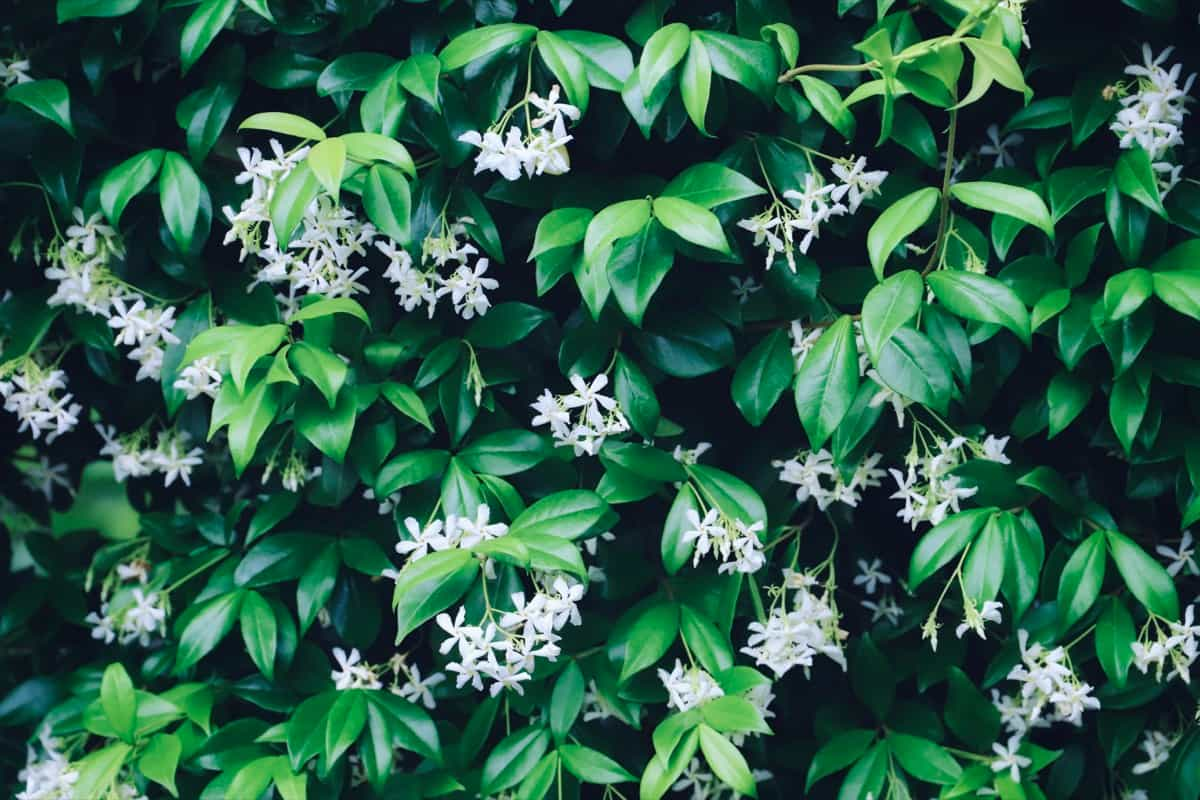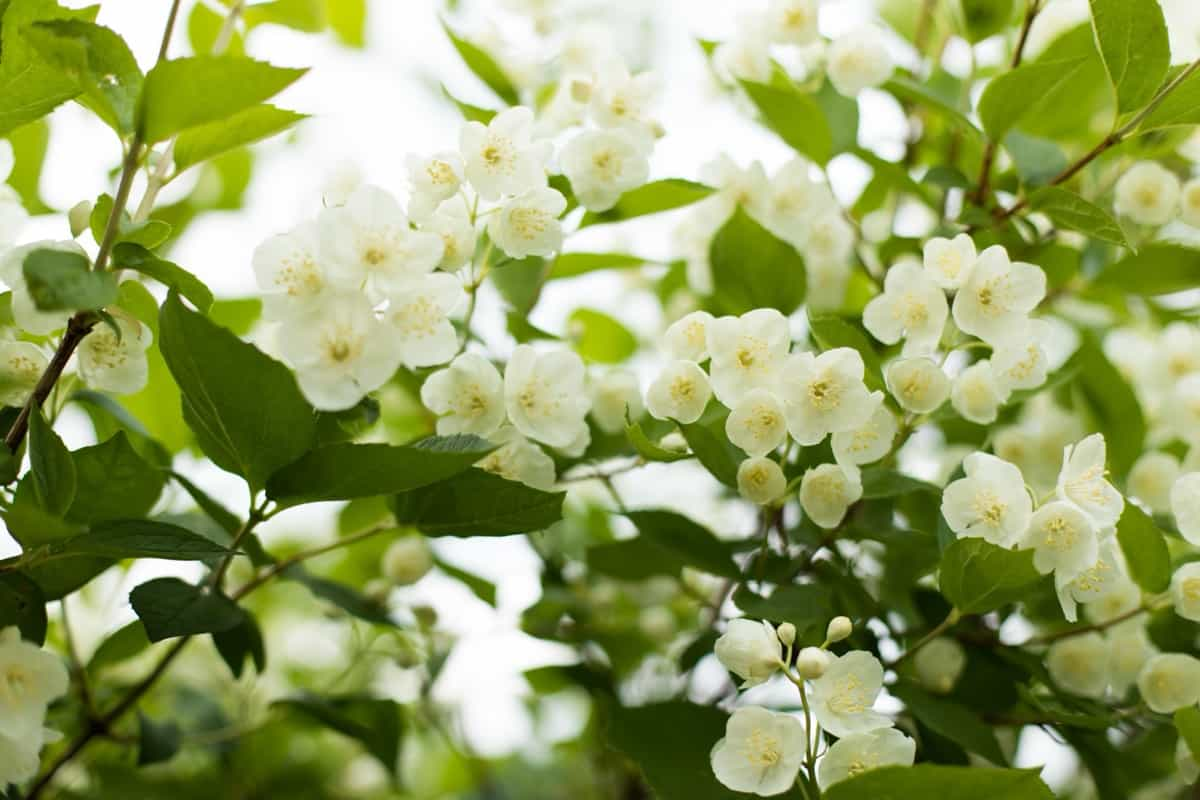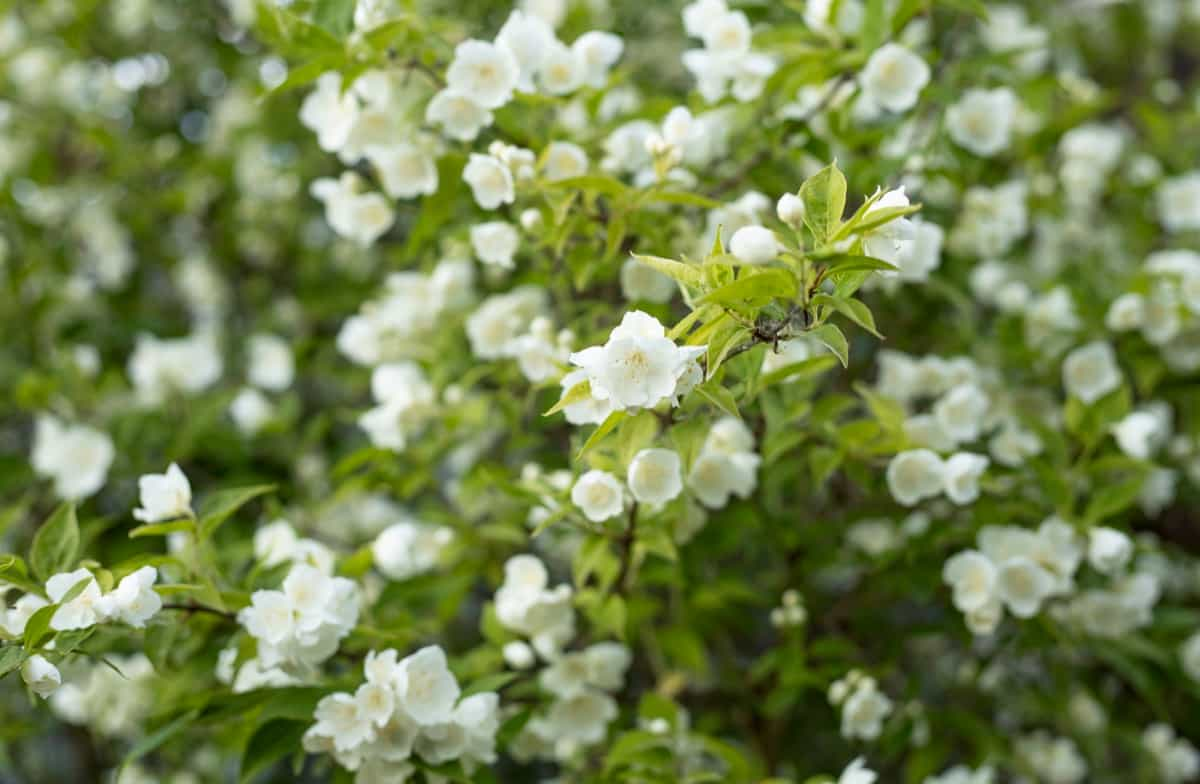Jasmine plants are known for their delicate and fragrant blooms, but achieving optimal blooming requires a good understanding of their needs. These plants thrive in warm climates and prefer temperatures between 15 to 24°C. They also require plenty of sunlight, so it’s best to place them in an area that receives at least six hours of direct sunlight each day. Proper watering is crucial for Jasmine plants to bloom abundantly.

The right soil conditions are essential for healthy Jasmine blooms. Jasmine plants prefer well-draining soil with a slightly acidic pH level between 6 and 7. Regular fertilization during the growing season will provide the necessary nutrients for robust blooming. Pruning is key to encouraging new growth and maximizing blooms on Jasmine plants. Remove any dead or damaged branches regularly, as well as any crowded or tangled growth that may inhibit air circulation and sunlight penetration.
Jasmine plants thrive in moderate humidity levels ranging from 40% to 70%. Pest control plays a vital role in keeping Jasmine plants healthy and promoting abundant blooms. Monitor your plants regularly for pests like aphids or spider mites, which can damage foliage and impede flowering. Treat any infestations promptly with natural insecticides or organic pest control methods. To give your Jasmine plant an extra boost, consider using nutrient supplements designed specifically for flowering houseplants during their active growth period.
11 Strategies to Make Jasmine Plants Bloom
Provide Adequate Sunlight for Jasmine Plants
Jasmine plants are known for their delicate and fragrant blooms, but to achieve optimal blooming, it is crucial to provide them with adequate sunlight. When selecting a location for your Jasmine plant, choose an area that receives at least six hours of direct sunlight each day. If you don’t have a spot with full sun, Jasmine plants can tolerate partial shade as well. If you’re growing your Jasmine indoors, place it near a south-facing window where it can get ample sunlight throughout the day.
Alternatively, you can use artificial grow lights to supplement the natural light. It’s important to note that while Jasmine plants require sunlight to bloom, they also need some protection from intense afternoon sun during hot summer months. Excess direct sunlight can scorch their leaves and hinder blooming potential. Consider providing some shade or using sheer curtains if necessary.
Remember to rotate your potted Jasmine plant outdoors regularly so all sides receive equal exposure to sunlight. This will help promote even growth and prevent lopsidedness. By providing adequate sunlight for your Jasmine plants, you’ll create an environment conducive to blooming success.
In case you missed it: How to Plant Jasmine from Cuttings: A Complete Growing Guide for Beginners

Soil Conditions and Fertilization for Jasmine Blooms
The soil that your Jasmine plants grow in plays a crucial role in their blooming potential. To ensure optimal growth and abundant blooms, it’s important to pay attention to the soil conditions and provide proper fertilization. Make sure that the soil is well-drained. Jasmines prefer moist but not waterlogged soil. If the water doesn’t drain properly, it can lead to root rot and other problems. Choose a loose, loamy, or sandy soil mix that allows excess water to drain away. Consider the pH level of the soil.
Jasmines thrive best in slightly acidic to neutral soils with a pH range of 6-7. Use natural amendments like compost or peat moss to adjust the pH if necessary. In terms of fertilization, Jasmines are moderate feeders and benefit from regular applications of balanced fertilizer. Consider incorporating organic matter into the soil annually by adding compost or well-rotted manure around the base of your Jasmine plants. This helps improve nutrient content and overall structure while providing essential micronutrients required for healthy Jasmine blooms.
Prune and Train Jasmine Plants for Maximum Blooms
Pruning and training your Jasmine plants is a crucial step in ensuring maximum Jasmine blooms. By properly pruning and shaping the plant, you can encourage healthy growth and abundant flowers. Look for any dead or damaged branches that need to be pruned away. Use sharp bypass pruners to make clean cuts just above a leaf node or bud. Next, consider the desired shape of your Jasmine plant.
In case you missed it: 13 Common Jasmine Plant Problems: How to Fix Them, Solutions, and Treatment

You can train it as a bushy shrub or guide it along a trellis or support structure for vertical growth. Carefully prune and trim branches accordingly to achieve the desired shape. Regular pruning helps remove old wood and stimulates new growth, which leads to more blooms. Aim to prune after flowering, typically in early spring before new growth begins. When pruning, always cut back about one-third of the length of each branch. This encourages branching from lower nodes and promotes fuller foliage and more flower buds.
Temperature and Humidity Control for Jasmine Blooms
Jasmine plants are known for their love of warmth and humidity, making temperature and humidity control crucial for optimal blooming. These delicate beauties thrive in temperatures between 15-24°C, so it’s important to keep them in a warm environment. During the summer months, when the heat can get intense, providing some shade during the hottest parts of the day can help protect Jasmine plants from scorching. This can be achieved by placing them near larger plants or using a shade cloth.
Humidity plays a key role in Jasmine’s blooming. These plants prefer higher humidity levels, ideally around 50-70%. To increase humidity, mist the leaves regularly with water or place a tray filled with water near the plant. If you live in an area with low natural humidity, consider using a humidifier indoors or grouping your Jasmine plants to create a microclimate that retains moisture.
Pest and Disease Management for Healthy Jasmine Plants
These beautiful flowers can be susceptible to various pests, including aphids, spider mites, and whiteflies. Regular inspection is key to catching any infestations early on. To combat these pesky insects, try using natural remedies. These products are effective in controlling pests without harming the plant or the environment. Additionally, introducing beneficial insects like ladybugs can help keep pest populations under control.
Disease prevention is equally important when it comes to Jasmine plants. Common diseases that affect these plants include powdery mildew and root rot. To prevent powdery mildew, ensure proper air circulation around your plants by avoiding overcrowding. Proper watering techniques also play a role in preventing disease.
Enhance Bloom with Nutrient Supplements
One of the key factors in promoting optimal blooming for Jasmine plants is providing them with the right nutrients. Choosing the right nutrient supplements is crucial. Look for products that contain high levels of phosphorus, which stimulates flower production. Nitrogen-rich fertilizers may encourage lush foliage growth but can inhibit blooming, so it’s important to strike a balance.
In case you missed it: Growth Stages of Flowering Plants: Rose, Marigold, Hibiscus, Dahlia, Gerbera Daisy, and Jasmine

When applying nutrient supplements, follow the manufacturer’s instructions carefully to avoid over-fertilizing and damaging your plants. It’s usually best to apply them during the growing season when your Jasmine plant is actively producing new growth. Consider using organic options like compost tea or seaweed extract as natural alternatives to synthetic fertilizers. These natural additives not only provide essential nutrients but also improve soil structure, creating a healthier environment for your Jasmine plants to thrive.
Propagation Methods to Increase Blooming Potential
When it comes to increasing the blooming potential of your Jasmine plants, propagation can be a game-changer. By multiplying your plant collection through various methods, you’ll not only enjoy more blooms but also share their beauty with others. One popular propagation method is stem cuttings. Select healthy stems that are free from diseases and pests. Make a clean cut and remove any lower leaves. Dip the cutting end in rooting hormone and plant it in a well-draining potting mix. Provide indirect sunlight until roots develop.
Another effective technique is layering. Choose a low-growing branch on your existing Jasmine plant that has nodes close to the ground. Gently wound or scrape off some bark at one of these nodes, then bury this section in fertile soil while keeping it attached to the parent plant. The buried node will eventually form roots, allowing you to separate it as its thriving Jasmine bloom producer.
A less common but equally successful approach is air layering. Begin by selecting a healthy branch with good growth near an upper leaf node on your mature Jasmine plant. Remove any leaves around this area and make an upward diagonal incision just above the chosen node. Wrap this section with damp sphagnum moss, securing it tightly with plastic wrap or twine. Within weeks, new roots should start forming within the moss ball. Once rooted, sever this new plant from its parent branch—now you have another blooming powerhouse.
Use Support Structures for Jasmine Plants
Jasmine plants are known for their delicate and fragrant blooms, but sometimes, they need a little extra help to reach their full potential. One of the most common types of support structures is a trellis. A trellis consists of a framework of vertical posts with horizontal bars or wires that the Jasmine vines can cling onto as they grow upwards. This not only helps keep the plant upright but also encourages upward growth, leading to more abundant blooms.
Another option is using stakes or poles to guide the Jasmine vines. Stakes can be made from bamboo, wood, or metal, depending on your preference. If you have limited space or prefer a more compact look, consider using an obelisk-shaped structure for your Jasmine plant. These decorative towers provide vertical support while adding an elegant touch to your garden.
In case you missed it: How to Grow Jasmine Flowers at Home in the USA: From Seeds, Cuttings, Faster, In Backyards, Indoors, and In Containers

When choosing a support structure for your Jasmine plants, make sure it’s sturdy enough to withstand strong winds and heavy foliage. You don’t want it toppling over and damaging your precious blooms. Supporting your Jasmine plants with these structures not only enhances their aesthetic appeal but also promotes healthier growth by allowing adequate air circulation around the leaves and flowers. Remember that each type of Jasmine may require different types of support based on its growth habits and vine thickness.
Mulch and Weed Control for Improved Blooms
Mulch and weed control play a crucial role in ensuring improved blooms for Jasmine plants. When it comes to mulching, the key is to choose the right material and apply it correctly. Organic mulches like wood chips or straw not only help retain moisture but also provide essential nutrients as they break down over time. Applying mulch around the base of your Jasmine plants can help regulate soil temperature, prevent weed growth, and conserve moisture.
This creates an optimal growing environment for your plants, allowing them to focus their energy on producing beautiful blooms. Weeds can compete with Jasmine plants for water, sunlight, and nutrients. It’s important to regularly check your garden beds for any unwanted intruders and promptly remove them before they take root. Pulling weeds by hand or using a small tool can be effective in preventing them from overshadowing your precious Jasmine blooms.
Monitor and Adjusting pH Levels for Blooming Jasmines
Maintain the right pH levels for Jasmine plants to bloom abundantly. The pH scale measures acidity or alkalinity, with 7 being neutral. Jasmine plants prefer slightly acidic to neutral soil, with a pH level between 6 to 7. If the pH level is too high (alkaline), you can lower it by adding organic matter such as compost or well-rotted manure. Alternatively, sulfur or vinegar diluted in water can be used as natural acidifiers.
On the other hand, if your soil is too acidic, you can raise its pH level by adding agricultural lime or wood ash. Remember to follow application instructions carefully to avoid overdoing it. Adjusting and maintaining proper pH levels ensures that nutrients are readily available for absorption by Jasmine plants’ roots. This allows them to thrive and produce vibrant blooms throughout their blooming period.
Companion Planting to Boost Jasmine Bloom
When it comes to gardening, sometimes the secret lies in the company you keep. Companion planting is a strategy that involves growing certain plants together to enhance their growth and overall health. One excellent companion plant for Jasmine is Lavender. Not only does lavender add a delightful fragrance to your garden, but it also acts as a natural pest repellent, keeping those pesky insects away from your precious Jasmine flowers.
In case you missed it: Jasmine Gardening For Beginners – How to Start, FAQs

Another great companion for Jasmine is a Marigold. These vibrant yellow or orange flowers not only brighten up your garden but also attract beneficial insects that feed on pests harmful to Jasmine. If you want to give your Jasmine even more support, consider planting it alongside climbing roses or clematis vines. These taller plants provide shade and act as a trellis for the delicate Jasmine tendrils to cling onto.
Basil and Mint are excellent choices as they repel aphids while adding flavor and aroma to both your culinary creations and garden space. By strategically selecting companion plants that complement each other’s growth patterns, repel pests, or improve soil quality, you can create an environment where your Jasmine thrives and blooms abundantly.
Conclusion
Jasmine plants are a true delight for any gardener or plant enthusiast. With their delicate and fragrant blossoms, they add beauty to any garden or indoor space. With the right strategies and care, you can enjoy the sight and fragrance of a beautifully bloomed Jasmine plant in your home or garden.
By understanding the blooming process of Jasmine, considering factors that affect blooming, choosing the right location, practicing proper watering and fertilization techniques, and utilizing pruning and training methods, you can encourage your Jasmine plant to thrive. By implementing these strategies diligently throughout the growing season, you’ll be rewarded with an abundance of fragrant blossoms on your Jasmine plant.
- How to Grow Hibiscus from Flower
- Plantation Ideas for Home Decoration: A Beginners Guide
- Flower Garden Designs and Layouts for Beginners
- Planting and Spacing Techniques in Papaya: A Beginner’s Guide
- Growing Gold: Essential Techniques for Planting Pineapples
- How to Make Kalanchoe Plant Bushy: Home Remedies and Solutions
- 11 Reasons Why Your Gardenia is Not Blooming: Home Remedies and Solutions
- Eco Elegance: The Guide to Designing a Drought-Tolerant Landscape
- Gardening on a Slope: Strategies for Hillside Landscaping
- Nourish and Flourish: Top Organic Mulches for Thriving House Plants
- Everything You Want to Know about Indian Mogra Flower: Discover Uses and Growing
- Green Thumb Success: Expert Tips for Cultivating Greenhouse Pumpkins All Year Round
- Maximize Growth & Flavor: The Ultimate Guide to Companion Planting in Herb Gardens
- How to Control Rhododendron Problems Naturally: Home Remedies and Organic Ways to Fix Them
- Natural Magic: The Remarkable Benefits of Cinnamon for Plants
- Best Steps to Revive Dying Tulip with Natural and Organic Treatment
- 10 Reasons Why Your Angel Trumpet is Not Blooming: Remedies and Treatment
- How to Fix Periwinkle Leaf and Flower-Related Problems: Natural Remedies and Solutions
- How to Fix Zinnias Leaf and Flower Problems: Discover Natural and Home Remedies
- Organic Steps to Induce Lemon Tree Flowers: A Comprehensive Guide
- Bloom Booster: Crafting the Perfect Homemade Bougainvillea Fertilizer
- Optimizing Growth: A Guide to Applying NPK Fertilizer for Potted Plants
- 10 Best Homemade Fertilizers for Rubber Plant: DIY Recipes and Application Method
- How to Boost Female Pumpkin Flowers: Effective Steps for More Flowers and High Yields
- Transform Your Indoor Garden: Top Benefits of Pink Salt for Houseplants
- 10 Best Homemade Fertilizers for Peacock Plants (Calathea): Easy DIY Guide
- Unlock Blooms: 9 Reasons Why Your Potted Chrysanthemum is Not Blooming
- 8 Reasons Why Your Potted Hibiscus is Not Blooming: Fix it with Simple Solutions
- Unlock Blooms: 9 Key Reasons Your Potted Frangipani Won’t Flower
- 10 Reasons Why Is My Ice Plant Not Blooming: Remedies and Treatment
- 10 Reasons Why My Potted Hydrangea Not Blooming: Treatment and Remedies
- 10 Reasons Why is My Wisteria Not Blooming: Remedies and Treatment
- 10 Reasons Why is My Goldfish Plant Not Blooming: Remedies and Treatment
- Maximize Your Space: Ultimate Guide to Balcony Gardening with Grow Bags
- 10 Reasons Why Your Iris is Not Blooming: Remedies and Treatment
- 10 Reasons Why Your Anthurium Plant is Not Blooming: Treatment and Remedies